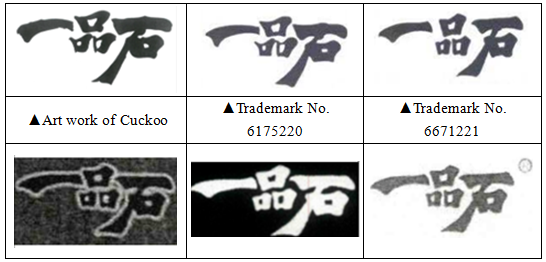CUCKOO Finally Won The Retrial And Won The Overall Lawsuit Six Years After It Encountered Malicious Squatting And Malicious Lawsuits!
April 24, 2022Case Summary:
Korea Cuckoo was established in 1978 and was dedicated to the research, development and manufacture of high-pressure rice cookers and household appliances. In 2006, Korea Cuckoo developed rice cookers with inner pots made of gold-plated brass, natural talc, cast iron, etc., and named them as the series of golden copper, Yipinshi, and famous blacksmith, etc., and specially hired a design company to design artistic marks. In the market in the same period, only Korea Cuckoo designed and produced the rice cooker with a pot of pure stone. The rice cooker with "Yipinshi" inner pot product gained widespread attention as soon as it was launched. Korea Cuckoo has a subsidiary Qingdao Cuckoo Electronics Co., Ltd. (“Qingdao Cuckoo”) and carries out its business in China through Qingdao Cuckoo.
In July 2007, ZHENG, a resident of Zhanjiang, Guangdong Province, applied for the registration of the Trademark No. 6175220 "一品石" (Yipingshi) on kitchen appliances such as "Pressure cookers, electric", and established a company in Zhanjiang in August of the same year. In April 2008, ZHENG applied for the registration of another trademark, the Trademark No. 6671221 "一品石" (Yipingshi). The font of this trademark was slightly different from that of the previous one. The copyright patterns and the relevant marks involved are shown in the following figure:
The above two trademarks of ZHENG were approved for registration in February and May 2010 respectively. Five years after the two trademarks were registered, ZHENG began to file administrative complaints to the industry and commerce department for trademark infringement of Qingdao Cuckoo and its distributors since November 2015. Cuckoo also filed applications for 3-year non-use revocation and invalidation against ZHENG's "一品石" (Yipinshi) trademarks since 2016 after being sued by the administrative complaints. However, due to the approval and registration of the trademarks for five years and other factors, the registered trademarks had not been successfully revoked or invalidated.
In June 2016, ZHENG and the company in Zhanjiang filed a lawsuit with the court against Qingdao Cuckoo.
Case Analysis:
After accepting the entrustment, Unitalen attorney suggested that Cuckoo make defense from perspectives such as the prior copyright, and files counterclaim or separate lawsuit against ZHENG and the company in Zhanjiang for copyright infringement. Since the court of first instance did not accept Qingdao Cuckoo's counterclaim, Qingdao Cuckoo separately filed a lawsuit against ZHENG and the company in Zhanjiang for copyright infringement.
Based on the facts of the two cases, the outcome of the copyright case is crucial. The key lies in the collection of evidence and reasoning about the originality and possibility of access of the opposite party of the work "  ". To this end, after discovering a large amount of evidence, Unitalen attorney believes that the existing pattern of the calligraphic characters have met the requirements of the Copyright Law for the originality of work, and constitutes a work of calligraphy art. At the same time, from the perspectives of probability, logical reasoning, and high probability, it is emphasized that the accused party has the possibility of access by proving that the accused party maliciously squatted a number of well-known brands including other Korean brands, and combining with the situation that the accused mark is highly similar to the prior art work.
". To this end, after discovering a large amount of evidence, Unitalen attorney believes that the existing pattern of the calligraphic characters have met the requirements of the Copyright Law for the originality of work, and constitutes a work of calligraphy art. At the same time, from the perspectives of probability, logical reasoning, and high probability, it is emphasized that the accused party has the possibility of access by proving that the accused party maliciously squatted a number of well-known brands including other Korean brands, and combining with the situation that the accused mark is highly similar to the prior art work.
For the trademark infringement case, Unitalen attorney emphasized the prior copyright of Cuckoo in defense, the trademarks maliciously registered by ZHENG and others have no substantial legality, their malicious exercise of trademark rights constitutes abuse of rights, and their claims shall not be supported, based on the judgment rules of the "ELLASSAY" case, the guiding case No. 82 of the Supreme Court.
Court Decision:
Qingdao Cuckoo's claims in the two cases were not accepted by the court in the first and second instance procedures, so the case was appealed to the Supreme People's Court for retrial of the two cases in accordance with the law. After reviewing the two cases, the Supreme People's Court ruled to bring the cases to trial in accordance with the law.
After trial, the Supreme Court determined in the copyright retrial case that the pattern of calligraphic characters " " is the result of personalized selection, choice, and arrangement, and belongs to the author's original expression, which constitutes a work of art in the sense of copyright law. The alleged infringing mark used the original expression part of the art work "
" is the result of personalized selection, choice, and arrangement, and belongs to the author's original expression, which constitutes a work of art in the sense of copyright law. The alleged infringing mark used the original expression part of the art work "  " after excluding the creative materials in the public domain, and the two constituted substantial similarity. The possibility of access in the copyright law is not limited to the access to domestic works. For works published abroad, domestic subjects may also have possibility of access. Whether the alleged infringing mark has been registered as a trademark cannot be a legitimate defense for infringing the copyright of others. Accordingly, the Supreme Court ruled to revoke the first and second instance judgments in the retrial judgment and additionally ruled that ZHENG and the Zhanjiang company to cease infringement and assume compensation liability.
" after excluding the creative materials in the public domain, and the two constituted substantial similarity. The possibility of access in the copyright law is not limited to the access to domestic works. For works published abroad, domestic subjects may also have possibility of access. Whether the alleged infringing mark has been registered as a trademark cannot be a legitimate defense for infringing the copyright of others. Accordingly, the Supreme Court ruled to revoke the first and second instance judgments in the retrial judgment and additionally ruled that ZHENG and the Zhanjiang company to cease infringement and assume compensation liability.
In the trademark right retrial case, the Supreme Court determined that: in this case, since the act of ZHENG and the Zhanjiang company of acquiring and exercising the involved trademark right is based on infringing the lawful prior copyright of Qingdao Cuckoo, such act violated the principle of honesty and credibility and has no legitimacy, but they still filed a trademark infringement lawsuit against Qingdao Cuckoo on this basis, such litigation act constituted an abuse of right, and its litigation claims lacked a legitimate rights basis and were not supported. Accordingly, the Supreme People's Court ruled to revoke the judgments of the first and second instances, and re-ruled to dismiss the claims of ZHENG and the Zhanjiang company.
Typical Significance:
In this copyright retrial case, the Supreme People's Court's determination of the originality of calligraphy art works, judgment of substantial similarity, presumption of possibility of access, and comprehensive and objective review and determination of relevant evidence using logical reasoning and daily life experience all have guiding significance for similar cases.
The Supreme People's Court's judgment on the trademark infringement retrial case once again demonstrates the determination of the Chinese judicial authorities to stop illegal squatters from trying to make malicious claims through registered trademarks that are legitimate in form from the judicial aspect, and provides another classic precedent on how rights holders can legally protect their rights in similar situations.





